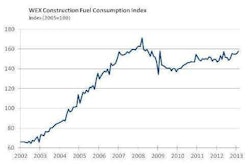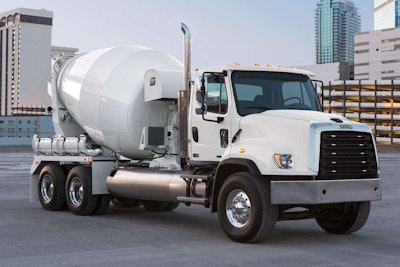 The Freightliner 114 SD uses a Cummins Westport ISL G that runs on compressed natural gas.
The Freightliner 114 SD uses a Cummins Westport ISL G that runs on compressed natural gas.Remember when diesel was $2 a gallon and you could drive your big trucks without gasping at the cost of a fill-up?
Those days may be coming back, although it won’t be diesel that’s costing $2 a gallon, but natural gas.
Thanks to fracking and horizontal drilling techniques developed in just the last decade, domestic petroleum sources have grown so much that last year the United States produced more barrels of oil than Saudi Arabia.
In fact, many experts think that the United States will become totally energy self-sufficient by 2020.
This new drilling technology has also uncovered a bonanza of natural gas. As with any commodity though, when supplies increase, prices decrease. The sudden drop in natural gas prices has opened up an intriguing prospect for contractors who run fleets of trucks—fueling everything from half-ton pickups to Class-8 heavy haulers and vocational trucks.
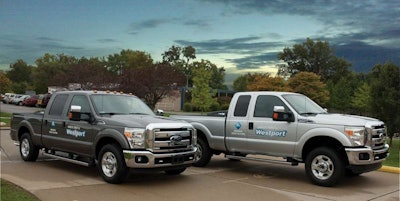 The Westport WiNG Power system runs CNG in a bi-fuel arrangement and is now offered as an option in Ford F-450 andF-550 super duty chassis cab trucks. It offers a combined fuel range of 650 miles.
The Westport WiNG Power system runs CNG in a bi-fuel arrangement and is now offered as an option in Ford F-450 andF-550 super duty chassis cab trucks. It offers a combined fuel range of 650 miles.Natural gas engines and retrofits are not cheap. Prices range from $5,000 to $11,000 for light- and medium-duty pickups to $30,000 to $40,000 for a Class 8 truck. But the key question is not cost but your return on investment (ROI). Does it pay to run a truck or a fleet of trucks on natural gas?
The answer depends on the price of natural gas and right now that price is trending at about $1.50 to $2 per diesel gallon equivalent. Because natural gas does not have the energy density of diesel, it takes about 1.4 gallons of natural gas to equal the energy output of 1 gallon of diesel. So rather than make you do the math, the industry uses the term diesel gallon equivalent, or DGE to compare the two. A DGE of natural gas has the same energy content and will do the same amount of work as one gallon of diesel fuel, even though a DGE of natural gas will be larger in volume than a gallon of diesel.
The other key metric fleet managers are watching is the difference between the DGE price of natural gas and the price of diesel. As long as that difference stays in the $1.50 to $2 range, natural gas trucks can make financial sense for your fleet. And most experts, including Joel Feucht, Caterpillar’s director for gas engine strategy, predict that the $1.50 to $2 price spread is here to stay. Right now it’s a little better than $2.50.
As with any new technology, there is some complexity associated with natural gas engines. So before we get into the details of the ROI, let’s examine the fuel, the engines and the refueling issues.
The clean burn
Natural gas is, in a word, methane, chemical symbol CH4. Propane comes out of the same wells and is also sometimes included under the term natural gas, but it is a different chemical, C3H8.
Once methane is extracted from the wells it is processed in one of two ways, creating two different products:
- LNG, or liquefied natural gas, is methane chilled to minus-260 degrees Fahrenheit, creating a liquid fuel. LNG is stored in insulated fuel tanks.
- CNG or compressed natural gas is methane that is compressed to 3,000 to 3,600 psi to reduce its volume to manageable levels. CNG is stored in thick, steel reinforced tanks.
In the right engine, LNG and CNG have almost the same horsepower and torque characteristics as diesel, so they’re perfectly suited to heavy applications. The key difference is they require more onboard storage room for the fuel tanks. This also limits the range of the vehicle, which is why natural gas trucks are best suited for what’s called hub-and-spoke operations.
In a hub-and-spoke arrangement, the truck leaves the hub or yard where it gets the fuel each day and returns to the same yard at night for refueling. This is one of the reasons the delivery and refuse industries have invested substantially in natural gas vehicles, but the hub-and-spoke concept also works well with many vocational trucks such as mixers and dump trucks.
Propane has performance characteristics more like gasoline, which is why it is a popular option for light and medium duty trucks. It only needs pressurization to about 300 psi and is less complicated to handle.
The engines
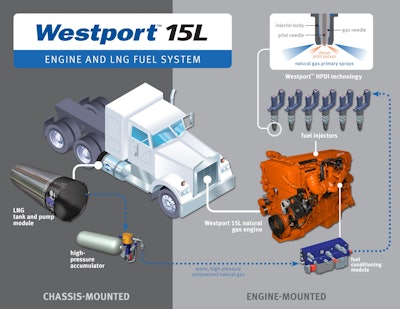
- Dual fuel. HPDI (high pressure direct injection) engines, sometimes called dual fuel, inject natural gas with a small amount of diesel to kick off the combustion in the cylinder. HDPI engines do not need spark plugs and the basic parameters of the diesel cycle are maintained. Partial diesel mode is possible but in normal operating situations diesel makes up only about 5 percent of the fuel used. These are popular in large displacement engines, 12 and 15 liter, and are being used in many big mining trucks.
- Bi-fuel. These engines run on both natural gas and diesel or gasoline, but not simultaneously. They require two separate fuel tanks, one for gasoline or diesel, the other for the natural gas. The beauty of bi-fuel trucks is that they don’t limit your range or restrict you to hub-and-spoke operations. You can run on the low-cost natural gas until you run out and then just flip a switch and run on the gasoline or diesel system until you have a chance to refuel with natural gas. GM, Ford and Chrysler are all offering bi-fuel pickup trucks, 3/4 ton and up. The only downside to bi-fuel trucks is that you sacrifice some room and payload capacity for the extra fuel tanks.
- Dedicated natural gas engines are spark ignited and run and store natural gas only.
There are no substantial differences between natural gas engines and their diesel- or gasoline-burning counterparts. The main mechanical elements, the block, the pistons, the cams and cranks, remain the same. What are different (aside from the fuel storage tanks) are the fuel delivery systems and injectors. Since natural gas lacks the lubricating properties of diesel fuel, in many designs valve seats are hardened to better withstand wear.
Fueling
Filling up a natural gas truck with LNG, CNG or propane is not quite as simple as tanking up with diesel or gasoline.
CNG and propane use pressurized systems. CNG refueling stations offer a “timed” fill or a fast fill. Timed fills can take 5 to 8 hours (you leave it overnight) but result in a more complete fill and it’s less expensive. “Fast” fills happen almost as quickly as filling with diesel, but require more fuel storage and pressurization, which makes this slightly more expensive.
LNG fills about as fast as diesel, but because it’s cryogenic, you must wear gloves, eye protection and closed toed shoes.
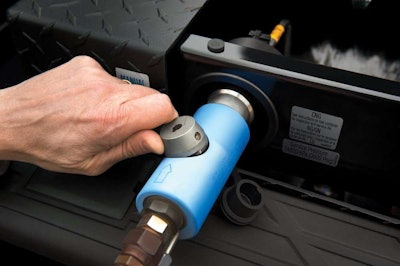 The 2013 bi-fuel Chevrolet Silverado HD includes a compressed natural gas (CNG) capable engine that seamlessly transitions between CNG and gas fuel systems. The CNG and gasoline tanks have a combined range of 650 miles, the longest standard bi-fuel range of any original equipment automaker.
The 2013 bi-fuel Chevrolet Silverado HD includes a compressed natural gas (CNG) capable engine that seamlessly transitions between CNG and gas fuel systems. The CNG and gasoline tanks have a combined range of 650 miles, the longest standard bi-fuel range of any original equipment automaker.With any of these fueling procedures, some training and familiarity with the equipment is required.
As of last year in the United States there were 992 CNG, 47 LNG and 2,500+ propane refueling stations. To find out if there are facilities near you go to: www.afdc.energy.gov/stations.
When it comes to propane, many propane suppliers will install refueling infrastructure at your yard in return for a fuel contract. And propane tanks and dispensers can be set up on skids and moved from jobsite to jobsite as needed.
For large quarry and mining operations some natural gas vendors are building refueling stations on their customers’ sites. These may be fed by pipelines or, where pipeline infrastructure is not available, a steady stream of natural gas delivery trucks.
Calculating ROI
Assuming you have a source for the fuel and applications that fit into a hub-and-spoke arrangement, the final piece of the puzzle is figuring out is natural gas trucks make financial sense for your company.
A study done by the National Energy Policy Institute found that a natural gas powered Class-8 truck needed to run about 70,000 miles a year to be economically attractive when natural gas was $1.50 cheaper than diesel (per DGE).
When diesel prices exceed natural gas prices by $2.50 per DGE (where it is currently) natural gas becomes an attractive option at 30,000 to 40,000 miles per year, according to the study.
For medium-duty pickup trucks, at $10,000 for the upcharge and a $2 a gallon difference between diesel and natural gas, you’d have to consume the equivalent of 5,000 gallons of diesel to break even. If you’re currently getting 12 mpg on your medium duty truck, that’s only 60,000 miles, and remember that after you reach the breakeven point, the $2 per gallon saved drops straight to your pocketbook. Chesapeake Energy Corp converted 5,000 of its vehicles to GM’s natural gas system and claims savings of $11 million to $12 million annually on fuel costs.
With propane at $1.50 a gallon on a vehicle traveling 20,000 miles a year, look for a payback within 15 to 18 months.
Grants and financial incentives for natural gas vehicles and conversions are available in some areas. Check out Cascade Sierra Solutions and the federal Clean Cities Coalition. And the federal government maintains a database of natural gas incentives and laws which you can find at www.afdc.energy.gov/fuels/laws/3253.






